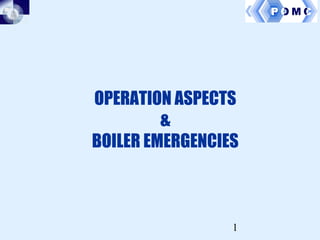This document discusses various operational aspects and emergencies that can occur in an atmospheric fluidized bed combustion (AFBC) boiler. It outlines important parameters to monitor such as bed height, air pressures, temperatures, and fuel sizes. It then describes several emergency conditions that can happen including low or high drum levels, high furnace pressure, high or low bed/furnace temperatures, tube failures, and flame failures. For each condition, it discusses potential causes, effects on the boiler, and recommended actions to address the problem.





















































